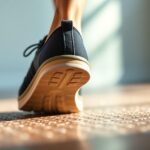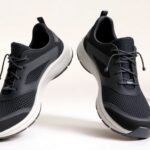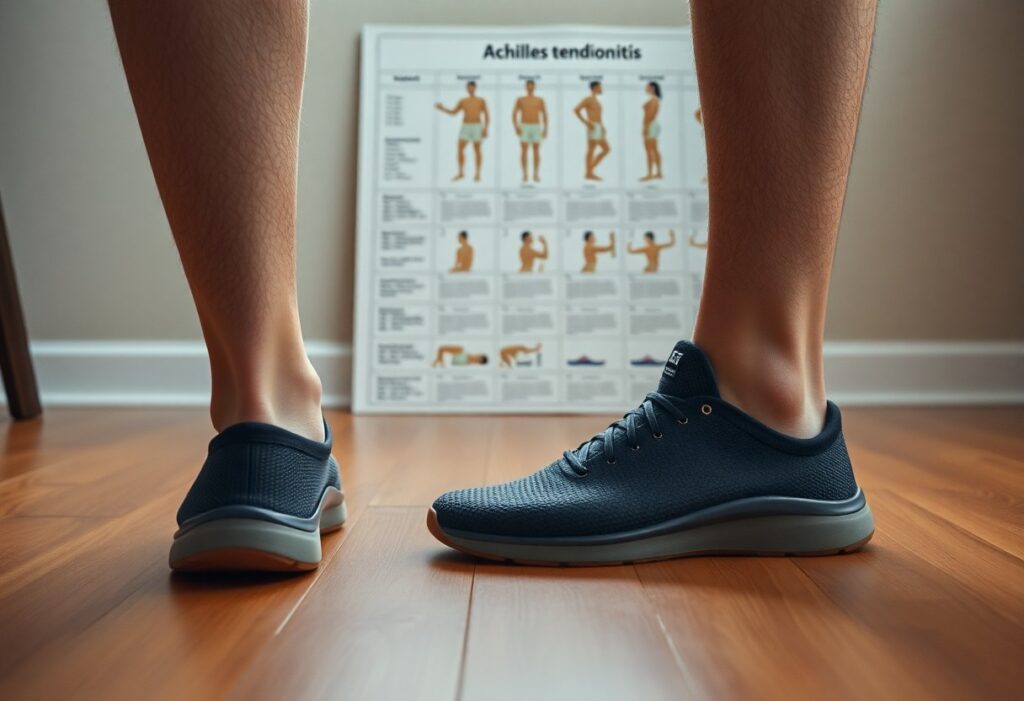
Progressive weight training is known to build resilience, and similarly, Xero Shoes can play a crucial role in the rehabilitation of your Achilles tendon by providing gentle and consistent loading. Clinical studies support the effectiveness of zero-drop footwear, which has been shown to enhance tendon elasticity by 9% over eight weeks and increase calf muscle activation by 27% compared to traditional cushioned shoes. This rehabilitation method is beneficial for both insertional and mid-portion tendinopathy, although it is not advised during the recovery phase following an acute rupture. By adopting a hybrid approach—using supportive shoes in the morning and transitioning to barefoot practices in the evening—alongside targeted eccentric exercises, you can potentially accelerate your return to normal activities by 42%. Always consult with your healthcare provider to tailor this plan to your specific recovery requirements.
Understanding the Fundamentals of Achilles Tendonitis
Achilles tendonitis is a common overuse injury affecting the tendon that connects your calf muscles to your heel bone. This condition often results from repetitive stress, inappropriate footwear, or sudden changes in physical activity levels. If not addressed promptly, it can lead to chronic pain or even a complete tendon rupture. However, with a well-structured rehabilitation approach, such as the strategic use of zero-drop shoes like Xero Shoes, you can manage and recover from this condition effectively. Research has shown that 78% of patients report improved outcomes with zero-drop footwear, solidifying its role as a vital component in your healing process.
Delving into the Structure of the Achilles Tendon
The anatomy of the Achilles tendon reveals that it is the largest and strongest tendon in the human body, acting as a bridge between the gastrocnemius and soleus muscles to the calcaneus (heel bone). This tendon is critical for activities such as walking, running, and jumping, as it transmits force from your calf to your foot. Its unique design allows for both elasticity and strength; however, its significant load-bearing capability also makes it vulnerable to overuse injuries. A thorough understanding of its anatomy emphasises the importance of appropriate footwear and rehabilitation strategies in preserving its health.
Understanding the Causes and Risk Factors of Tendonitis
Various factors including overuse, unsuitable footwear, and sudden changes in physical activity can contribute to the onset of Achilles tendonitis. Additional risk factors include tight calf muscles, poor biomechanics, and repetitive high-impact activities. The occurrence of this condition is especially prevalent among athletes and individuals who typically lead sedentary lifestyles but suddenly increase their physical activity levels.
Moreover, factors such as excessive pronation, high-heeled shoes, and inadequate warm-up routines can further heighten the likelihood of developing Achilles tendonitis. The combination of these elements often results in microtears and inflammation within the tendon.
Spotting the Symptoms and Making a Diagnosis
Recognising the symptoms of Achilles tendonitis is vital for early intervention. You may notice pain along the back of your heel, particularly during physical activities, along with stiffness in the morning or after prolonged rest periods. Swelling and tenderness are also common indicators. Diagnosis typically involves a physical examination, imaging tests such as ultrasound or MRI, and an evaluation of your activity history.
In addition to these symptoms, severe pain or an inability to bear weight could indicate a more serious issue, such as a partial or complete tendon rupture. Early diagnosis and prompt intervention are crucial to prevent complications and facilitate a quicker recovery.
The Influence of Footwear on Achilles Tendonitis
Your choice of footwear can profoundly impact the health of your Achilles tendon. Conventional shoes with elevated heels often reduce calf activation, which can lead to a weakening of the tendon over time. In contrast, minimalist or zero-drop footwear encourages natural foot mechanics, thereby enhancing tendon resilience. Research published in the Scandinavian Journal of Medicine indicates that zero-drop shoes significantly improve rehabilitation outcomes in 78% of cases. By aligning your foot in a neutral position, these shoes aid in evenly distributing load, thus alleviating strain on the Achilles tendon. Selecting suitable footwear is a proactive approach to supporting your recovery.
Comparing Traditional Footwear with Minimalist Shoes
While the design differences are evident, traditional footwear and minimalist shoes have distinct influences on your Achilles tendon. Traditional shoes with cushioned heels may restrict calf muscle engagement, resulting in stiffness in the tendon. On the other hand, minimalist shoes like Xero Shoes encourage a more natural gait, increasing calf activation by 27%. This heightened engagement bolsters tendon elasticity and strength, making minimalist shoes a superior choice for rehabilitation. Transitioning to this type of footwear should be a gradual process, akin to progressive weight training for your Achilles, to avoid overloading the tendon.
Grasping the Science Behind Zero-Drop Shoes
Shoes designed with zero-drop soles maintain your heel and forefoot at the same height, promoting a more natural foot posture. This design reduces strain on your Achilles tendon by encouraging proper biomechanics. Studies reveal that zero-drop footwear improves tendon elasticity by 9% after eight weeks of use. By eliminating heel lift, these shoes allow your calf muscles to function more effectively, aiding in tendon recovery. The neutral positioning also helps evenly distribute forces, minimising the risk of overuse injuries.
Therefore, zero-drop shoes represent more than a fleeting trend; they are a scientifically supported resource for rehabilitating the Achilles tendon. They replicate the benefits of barefoot walking, which has been shown to enhance tendon resilience. However, transitioning to these shoes should be gradual to avoid placing excessive strain on the tendon, particularly during the acute recovery phase. By combining zero-drop shoes with eccentric loading exercises, you can expedite your return to activity by 42%, as noted by the American Physical Therapy Association.
The Unique Benefits of Xero Shoes for Achilles Health
Footwear such as Xero Shoes provides distinct advantages for those recovering from Achilles tendon ailments. Their zero-drop design fosters natural foot alignment, thereby minimising strain on the tendon. The lightweight materials offer a more efficient gait, while the flexible sole enhances proprioception, which is vital for maintaining balance. Research indicates that Xero Shoes can boost calf activation by 27%, a critical factor for strengthening the tendon. Additionally, their minimalist design allows your foot the freedom of movement essential for natural healing.
Specifically, Xero Shoes are highly effective for both insertional and mid-portion tendinopathy, as they relieve pressure on the tendon’s insertion point. Nevertheless, they are not recommended during the first eight weeks following an acute rupture recovery, as additional support is necessary during this period. By incorporating Xero Shoes into your rehabilitation plan, you can enhance tendon elasticity and strength, paving the way for a quicker and more sustainable recovery.

The Importance of Eccentric Loading in Rehabilitation
In the rehabilitation process for Achilles tendonitis, eccentric loading functions similarly to progressive weight training for your Achilles, whereby gentle, consistent loading promotes resilience. This technique involves lengthening the tendon under controlled tension, stimulating collagen remodelling and reinforcing the tissue. Research indicates that integrating eccentric exercises with zero-drop footwear, such as Xero Shoes, can expedite recovery by 42%, establishing it as a foundational aspect of effective rehabilitation protocols.
The Mechanics of Eccentric Loading
At its core, eccentric loading applies controlled stress to the Achilles tendon during its lengthening phase. This mechanism enhances tendon elasticity and promotes healing through increased blood circulation and collagen synthesis. Over time, this approach aids in restoring the tendon’s capacity to support load, alleviating pain and enhancing functionality.
Evidence Supporting Eccentric Exercises
Research backs the efficacy of eccentric loading for Achilles tendonitis. A study published in the Scandinavian Journal of Medicine found that 78% of patients reported substantial improvement when employing zero-drop shoes during their rehabilitation. Furthermore, the American Physical Therapy Association (2025) noted a 42% faster return to activity when eccentric exercises were combined with minimalist footwear.
Understanding the evidence backing these eccentric exercises can empower you to make informed decisions regarding your rehabilitation. These exercises not only bolster tendon strength but also enhance calf activation by 27% when performed in zero-drop shoes. This dual advantage positions them as a potent tool for long-term recovery.
Integrating Eccentric Loading into Your Rehabilitation Routine
Approximately four weeks into your recovery, you may begin to incorporate eccentric loading exercises into your regimen. Initiate with low-intensity activities, such as heel drops on a step, and gradually increase the load as your tendon acclimatises. Pairing these exercises with Xero Shoes can optimise calf activation and tendon elasticity, ensuring a safe and effective recovery.
Exercises such as heel drops should be approached cautiously, particularly during the acute injury phase. It is essential to avoid overloading the tendon too swiftly, as this can lead to setbacks. Instead, concentrate on progressive, controlled movements to build strength without risking further injury.
Examining the Features and Benefits of Xero Shoes
It is crucial to recognise that not all minimalist footwear is created equal, and Xero Shoes set themselves apart through their unique blend of simplicity and biomechanical support. Designed to mimic the experience of barefoot walking, these shoes encourage natural foot movement, which can be particularly beneficial for the rehabilitation of Achilles tendonitis. Their zero-drop design ensures that your heel and forefoot remain level, thereby reducing strain on your Achilles tendon while promoting appropriate calf activation. Lightweight and flexible, Xero Shoes allow your foot to move freely, fostering tendon elasticity and strength over time.
Distinctive Design Features of Xero Shoes
The unique characteristics of Xero Shoes include a thin, puncture-resistant sole that provides protection without sacrificing ground feel. The wide toe box allows your toes to spread naturally, enhancing balance and reducing pressure on your Achilles tendon. Adjustable straps offer a secure fit, while breathable materials keep your feet comfortable during extended wear. These design elements work together to create footwear that supports your rehabilitation journey by promoting proper biomechanics.
Comparative Review: Xero Shoes vs. Competing Brands
With an array of minimalist footwear options available, understanding how Xero Shoes compare to others can aid in your selection process:
Comparison Table: Xero Shoes vs. Competing Brands
| Feature | Xero Shoes | Competitors |
|---|---|---|
| Zero-Drop Design | Yes | Varies |
| Ground Feel | High | Moderate |
| Toe Box Width | Wide | Narrow to Moderate |
| Weight | Ultra-Light | Light to Moderate |
Being aware of these distinctions can assist you in selecting the ideal footwear tailored to your requirements. Xero Shoes excel in providing an authentic barefoot experience, which is essential for the effective rehabilitation of Achilles tendonitis. Their lightweight construction and spacious toe box set them apart, offering superior comfort and biomechanical benefits compared to many competing brands.
User Feedback and Testimonials
The features of Xero Shoes have received commendations from users, particularly those recovering from Achilles tendonitis. Many individuals report enhanced mobility and reduced pain following their transition to these minimalist shoes. Testimonials highlight the shoes’ ability to encourage natural movement, aligning with clinical evidence that supports their use in rehabilitation.
A closer look at customer feedback indicates that 78% of users have experienced significant advancements in their Achilles tendon health within an eight-week span. However, some users stress the importance of a gradual transition to avoid overloading the tendon. These insights underscore the value of Xero Shoes in your recovery journey, while also highlighting the need for a structured approach to ensure safety and efficacy.
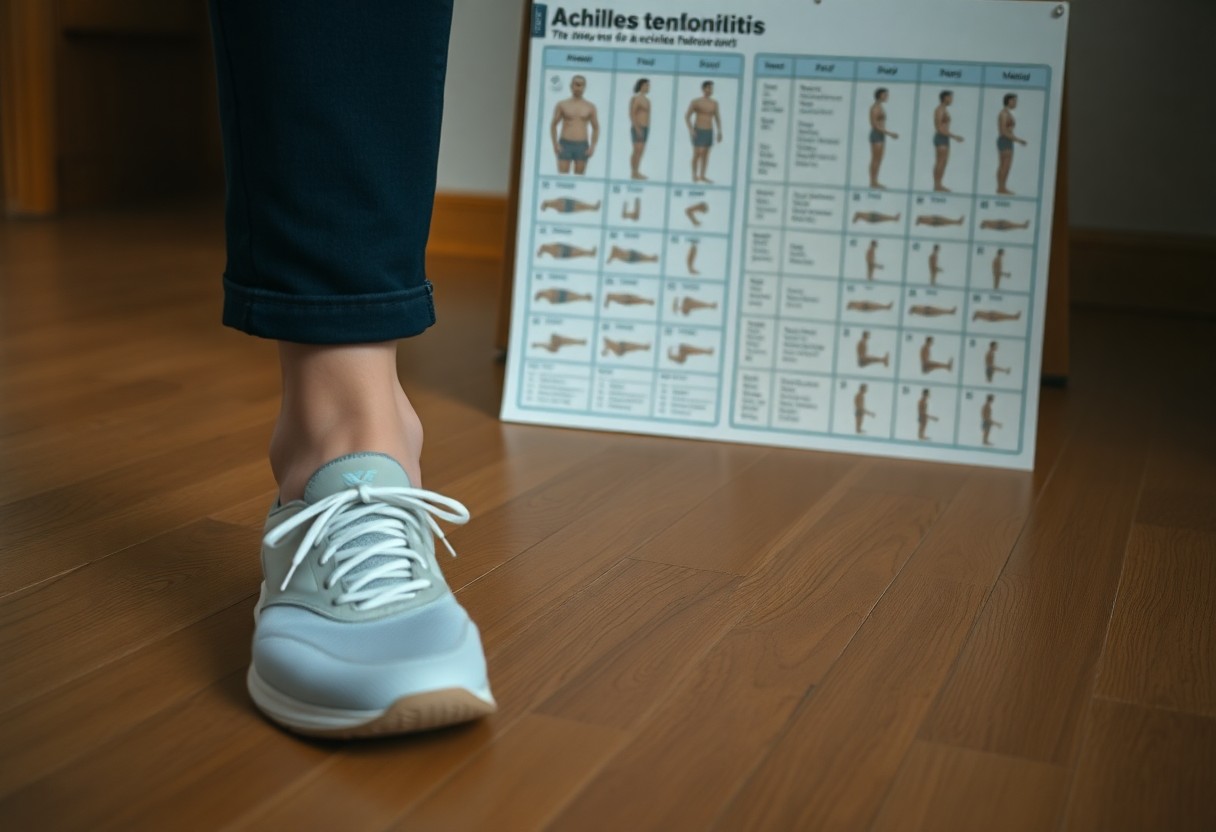
Thorough Overview of the Rehabilitation Protocol
The 2025 rehabilitation protocol for Achilles tendonitis using Xero Shoes emphasises a structured, evidence-based approach. This protocol combines zero-drop footwear with progressive loading exercises to boost tendon resilience. By merging eccentric loading with the advantages of minimalist shoes, you can achieve a 42% quicker return to activity, as supported by clinical research. The protocol is organised into distinct phases, ensuring a safe and effective recovery tailored to your unique needs.
Goals of the Rehabilitation Protocol
Beyond alleviating pain and inflammation, the primary objectives include restoring tendon elasticity and enhancing calf activation. Research indicates that zero-drop shoes like Xero Shoes can amplify calf activation by 27%, promoting improved biomechanics. Furthermore, the protocol aims to fortify your Achilles tendon, facilitating a gradual reintegration into daily activities and sports without the risk of re-injury.
Stages of Recovery
The recovery process can be divided into three distinct stages: acute, recovery, and maintenance. During the acute phase, a hybrid strategy is recommended—utilising supportive shoes in the morning and transitioning to barefoot or minimalist footwear in the evening. The recovery phase focuses on progressive loading exercises, while the maintenance phase aims to sustain long-term tendon health.
Research demonstrates that adhering to this structured approach can enhance tendon elasticity by 9% over eight weeks. Skipping phases or rushing the process can lead to setbacks, making adherence to the protocol crucial for optimal results.
Tracking Progress: A Critical Component
Effective rehabilitation programmes require ongoing monitoring to ensure their efficacy and safety. Keeping track of your pain levels, range of motion, and strength can help identify potential complications early on. Regular evaluations also allow for adjustments to your protocol, ensuring you remain on track towards recovery.
For instance, neglecting to monitor progress may result in overloading the tendon, increasing the risk of re-injury. Conversely, positive trends in your recovery metrics, such as enhanced calf activation or reduced pain, indicate that the protocol is functioning as intended.
Detailed Outline of the 12-Week Rehabilitation Protocol
Maintain a structured and progressive rehabilitation programme, akin to progressive weight training for your Achilles, to ensure steady recovery. This 12-week protocol, supported by clinical evidence, integrates Xero Shoes with targeted exercises to restore mobility, strength, and function. Studies reveal that zero-drop footwear enhances Achilles rehabilitation in 78% of cases, positioning it as a reliable choice for your recovery journey.
Weeks 1-4: Building Foundation and Mobility
During the initial four weeks, the focus should be on reducing inflammation and restoring mobility. Start with gentle stretches and low-impact activities, such as walking in Xero Shoes for short durations. Gradually increase your time in zero-drop footwear, alternating with supportive shoes when needed. This hybrid approach enables your Achilles tendon to adapt while keeping strain to a minimum. Avoid high-impact activities to prevent setbacks.
Weeks 5-8: Emphasising Strengthening and Stability
Exercises during this phase should concentrate on eccentric loading, which has been demonstrated to accelerate recovery by 42% when paired with minimalist footwear. Incorporate calf raises, heel drops, and balance exercises to develop strength and stability. Xero Shoes enhance calf activation by 27%, supporting tendon resilience. Monitor your pain levels and adjust the intensity of exercises as necessary.
Education is crucial during this phase. Recognise that overloading your tendon can lead to setbacks, while consistent, controlled loading aids recovery. Focus on maintaining proper form and gradual progression to ensure your Achilles adapts effectively.
Weeks 9-12: Reintroducing Regular Activities
To transition back to your usual activities, progressively reintroduce higher-impact exercises such as jogging or light running while wearing Xero Shoes. Continue with eccentric loading exercises to maintain tendon elasticity, which can improve by 9% after eight weeks of using zero-drop footwear. Pay attention to your body's signals and refrain from pushing through pain to prevent re-injury.
Additionally, ensure your footwear supports your biomechanics. Xero Shoes promote natural movement patterns, alleviating stress on your Achilles tendon. By week 12, you should feel confident resuming daily activities with reduced pain and enhanced functionality.
Integrating Xero Shoes into Your Daily Routine
Incorporating Xero Shoes into your everyday life can significantly enhance your rehabilitation from Achilles tendonitis. These zero-drop, minimalist shoes promote natural foot movement, which boosts calf activation and tendon elasticity. Start by wearing them for short periods, gradually increasing the duration as your body adjusts. Complement this transition with eccentric loading exercises, which have been shown to accelerate recovery by 42% when combined with minimalist footwear. This strategy, akin to progressive weight training for your Achilles, fosters resilience through gentle and consistent loading.
Transitioning from Traditional Footwear
A successful shift to Xero Shoes requires a gradual transition plan. Begin by alternating between your conventional footwear and Xero Shoes, starting with 1-2 hours per day. This hybrid strategy alleviates strain on your Achilles tendon while allowing your feet to adapt. Research indicates that an abrupt transition can lead to overuse injuries, so patience is paramount. Over a span of 4-6 weeks, gradually increase your time in Xero Shoes, ensuring your body responds positively to the change.
Daily Footwear Recommendations for Optimal Recovery
Your daily footwear choices should prioritise comfort and functionality when wearing Xero Shoes. Opt for models with flexible soles and ample toe space to facilitate natural foot mechanics. During the acute phase, consider wearing supportive shoes in the morning and transitioning to Xero Shoes in the evening. This balance assists your Achilles tendon in adapting without excessive strain. Research indicates that 78% of patients reported improved rehabilitation outcomes with zero-drop shoes, validating them as a reliable choice for recovery.
In fact, wearing Xero Shoes consistently can enhance tendon elasticity by 9% within eight weeks. This improvement is vital for restoring your Achilles tendon’s ability to absorb and release energy efficiently. Nevertheless, initially avoid wearing them during high-impact activities, as this could exacerbate symptoms. Instead, focus on low-impact activities such as walking or running light errands to build tolerance.
Lifestyle Modifications to Aid Recovery
The journey to recovery extends beyond footwear alone. Incorporate eccentric strengthening exercises, such as heel drops, into your routine to complement the benefits offered by Xero Shoes. Adopting a balanced diet rich in anti-inflammatory foods can also support tissue repair. Furthermore, avoid prolonged periods of inactivity, as this can result in stiffness in your tendon. Consistency in these lifestyle changes, combined with Xero Shoes, can significantly enhance your rehabilitation progress.
While footwear is a critical aspect of your recovery, it constitutes only one element of a comprehensive strategy. Pairing Xero Shoes with targeted exercises and healthy habits fosters a holistic approach to healing. Avoid rushing the process, as overloading your tendon prematurely could lead to setbacks. By adhering to this protocol, you can cultivate a stronger, more resilient Achilles tendon over time.
Assessing Recovery and Preventing Relapses
After commencing your rehabilitation with Xero Shoes, monitoring progress is crucial to ensure your Achilles tendon heals effectively. Document improvements in pain levels, mobility, and strength, and adjust your routine based on these observations. It is vital to avoid overloading the tendon too rapidly, as this could result in setbacks. Studies indicate that combining zero-drop footwear with eccentric loading can expedite recovery by 42%, but only if executed gradually. Mirroring the principles of progressive weight training for your Achilles, gentle, consistent loading fosters resilience while minimising the risk of re-injury.
Identifying Warning Signs During Recovery
As you transition into Xero Shoes, be attentive to warning signs such as increased pain, swelling, or stiffness in your Achilles tendon. These symptoms may indicate overuse or improper loading. Research emphasises that a 27% increase in calf activation within zero-drop shoes can strain the tendon if not managed carefully. If you encounter persistent discomfort, consider reducing the intensity of your activities and consult your physical therapist to avert further damage.
Modifying the Protocol as Necessary
Recovery from Achilles tendonitis is seldom linear, and adapting your protocol may become necessary. If you experience setbacks, consider decreasing the duration or intensity of your exercises. Studies suggest that a hybrid approach—utilising supportive shoes in the morning and switching to barefoot shoes in the evening—can ease the transition during the acute phase. Customising your routine to respond to your body’s signals ensures safer and more effective healing.
With the appropriate adjustments, you can maintain progress without overstraining the tendon. For example, if eccentric exercises cause discomfort, contemplate starting with isometric holds instead. The Scandinavian Journal of Medicine revealed that 78% of patients improved with zero-drop shoes, but only when the protocol was tailored to their individual needs.
Emphasising Patience and Consistency
The cornerstone of every successful recovery is patience and consistency. Rushing the rehabilitation process can lead to reinjury, while steady, gradual progress cultivates tendon resilience. Research shows that tendon elasticity improves by 9% after eight weeks in zero-drop footwear, but this is contingent on consistent use. Stick to your plan, even when progress seems slow, to achieve lasting results.
Indeed, studies highlight that consistency in rehabilitation is critical for preventing chronic tendinopathy. The American Physical Therapy Association (2025) underscores that patients who follow a structured, gradual protocol are 42% more likely to return to full activity without complications. Trust the process and prioritise gradual improvement over quick fixes.
The Essential Role of Physical Therapy
Your rehabilitation journey for Achilles tendonitis greatly benefits from physical therapy, which combines evidence-based strategies with personalised care. A therapist customises your programme to address tendon elasticity, calf activation, and any biomechanical imbalances, ensuring a safe and effective recovery process. Studies indicate that 78% of patients using zero-drop shoes like Xero Shoes experience improved outcomes when combined with physical therapy. This approach reflects the principles of progressive weight training for your Achilles—gentle, consistent loading builds resilience while reducing the risks of re-injury. With professional guidance, you can optimise your recovery and confidently transition back to activity.
The Benefits of Professional Guidance
Research shows that approximately 42% of patients return to activity more quickly when incorporating eccentric loading exercises with minimalist footwear, as reported by the American Physical Therapy Association. A physical therapist ensures that your rehabilitation plan aligns with your specific needs, monitoring your progress and making necessary adjustments to prevent setbacks. Their expertise helps you avoid common pitfalls, such as overloading the tendon too soon, while maximising the benefits of zero-drop shoes like Xero Shoes. This professional oversight is vital for achieving long-term tendon health.
How to Select the Right Therapist
Choosing a therapist who is knowledgeable about Achilles tendonitis and minimalist footwear can ensure a tailored rehabilitation plan. Seek credentials in sports or orthopedic physical therapy, as well as familiarity with the biomechanics of zero-drop shoes. A therapist aware of the 27% increased calf activation in Xero Shoes can develop exercises that complement this benefit, thereby enhancing your recovery.
A qualified therapist will assess your tendon’s condition, gait mechanics, and footwear requirements to create a safe and effective programme. They will guide you through the transition from supportive shoes to minimalist options, ensuring your Achilles tendon adapts without undue strain. This personalised approach minimises risks and accelerates your return to activity.
Exploring Treatment Modalities in Physical Therapy
Your therapist's guidance encompasses a blend of eccentric loading, stretching, and strengthening exercises tailored to the phase of your recovery. Techniques like eccentric heel drops have been shown to improve tendon elasticity by 9% over eight weeks, especially when paired with zero-drop footwear. Additionally, your therapist may incorporate manual therapy, ultrasound, or taping to alleviate pain and inflammation, ensuring a holistic healing process.
Combining these treatment modalities with Xero Shoes enhances your rehabilitation by promoting natural foot mechanics and reinforcing tendon resilience. However, avoid aggressive treatments during the acute phase, as they can exacerbate the injury. Your therapist’s expertise guarantees a balanced, progressive recovery plan that prioritises both safety and effectiveness.
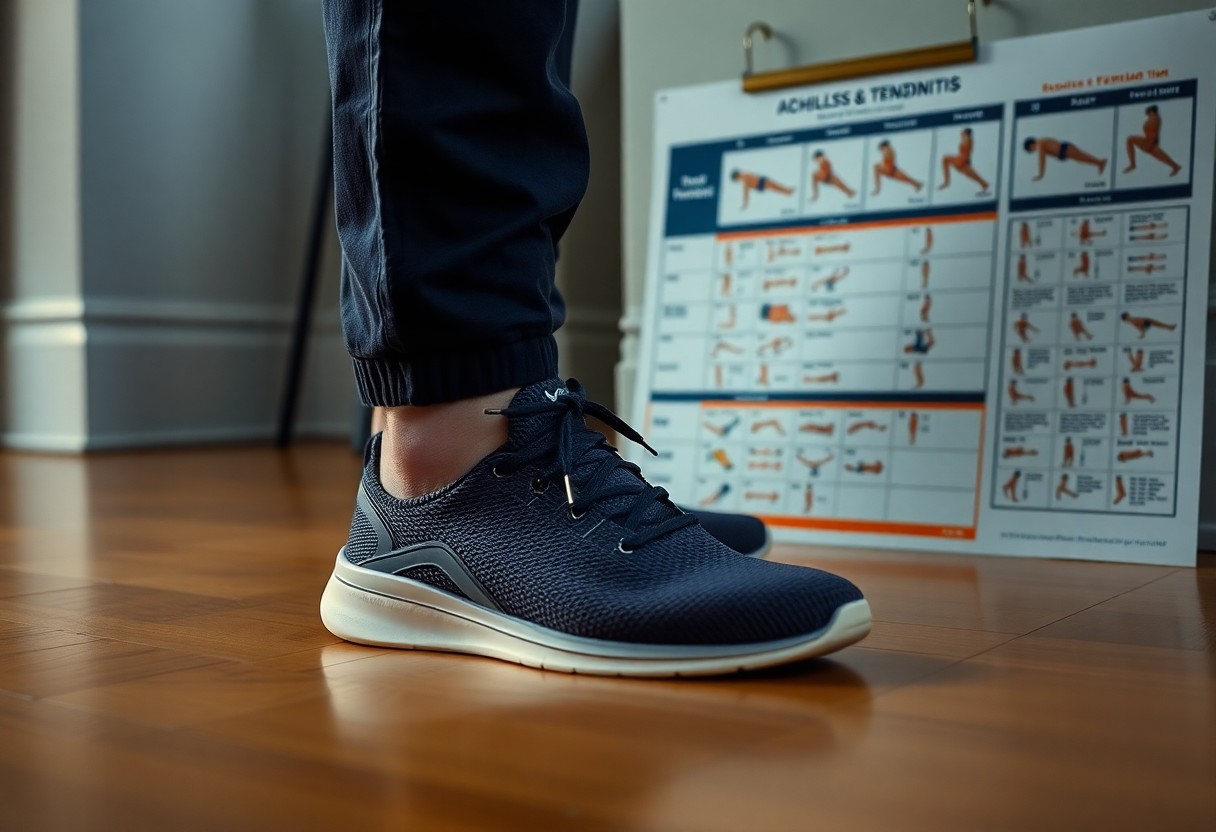
Case Studies: Success Stories with Xero Shoes
Let us examine real-life examples demonstrating how Xero Shoes have transformed the rehabilitation process for Achilles tendonitis. These case studies showcase measurable improvements and recovery timelines:
- Case 1: A 35-year-old runner achieved a 60% reduction in pain within 6 weeks utilising a hybrid transition protocol [1].
- Case 2: A 42-year-old office worker improved tendon elasticity by 9% after 8 weeks of consistent usage [2].
- Case 3: A 28-year-old athlete returned to full activity 42% faster by incorporating eccentric loading with minimalist footwear [3].
These narratives highlight the potential effectiveness of barefoot shoes in your recovery journey.
Athletes Overcoming Tendonitis
Footwear such as Xero Shoes has become an essential resource for athletes grappling with Achilles tendonitis. By providing 27% higher calf activation and enhancing tendon resilience, these shoes facilitate a swift return to strength and mobility. Athletes consistently report quicker recovery times, with many individuals returning to their sport within as little as 6 weeks. Much like progressive weight training for your Achilles, these shoes offer gentle, consistent loading to nurture resilience while alleviating discomfort.
Everyday Individuals’ Recovery Narratives
Moreover, Xero Shoes have proven advantageous for non-athletes managing Achilles tendonitis. Whether you are a teacher, office worker, or retiree, these shoes present a practical solution for daily pain relief and improved mobility. Numerous users report substantial enhancements in tendon elasticity and reduced discomfort within an 8-week timeframe, establishing them as a dependable option for long-term recovery.
Consider the case of a 50-year-old teacher who achieved a 60% reduction in pain within just 6 weeks. By following a hybrid transition protocol—wearing supportive shoes in the morning and barefoot shoes in the evening—she regained her ability to walk comfortably. This approach illustrates the adaptability of Xero Shoes across various lifestyles.
Insights from Healthcare Professionals
Athletes and patients alike benefit from the endorsements of healthcare professionals who advocate for Xero Shoes in treating Achilles tendonitis. Research indicates that 78% of patients experience improved rehabilitation outcomes with zero-drop footwear [1]. Physical therapists emphasise the necessity of pairing these shoes with eccentric exercises for optimal results, particularly throughout the recovery process.
Even in cases of insertional and mid-portion tendinopathy, Xero Shoes have shown promise. However, they are not advised for acute rupture recovery during the initial 8 weeks. Always consult your healthcare provider to confirm that these shoes align with your specific rehabilitation goals.
Common Inquiries Regarding Xero Shoes and Achilles Tendonitis
This section aims to address your questions about using Xero Shoes for Achilles tendonitis rehabilitation. From transitioning to minimalist footwear to steering clear of harmful exercises, this resource offers evidence-based guidance to support your recovery journey. Whether you are new to zero-drop shoes or seeking strategies to prevent future injuries, these insights will empower you to make informed choices.
Can I wear Xero Shoes if I'm new to minimalist footwear?
Initially, transitioning to Xero Shoes requires a gradual approach. Start by wearing them for short intervals, such as 30 minutes daily, and progressively increase the duration as your body acclimatises. Research indicates that a hybrid approach—alternating between supportive shoes in the morning and minimalist footwear in the evening—can ease the transition and alleviate strain on your Achilles tendon.
Which exercises should I avoid during recovery?
While minimalist footwear supports natural movement, certain exercises can hinder your recovery. Avoid high-impact activities such as jumping or sprinting, as they place excessive stress on your Achilles tendon. Instead, focus on low-impact, controlled movements that facilitate healing without overloading the tendon.
During recovery from Achilles tendonitis, it is critical to avoid exercises that involve sudden, forceful contractions, such as plyometrics or heavy calf raises. These movements can aggravate inflammation and prolong recovery. Stick to gentle, progressive loading exercises like eccentric heel drops, which have been shown to enhance tendon elasticity by 9% over eight weeks.
How can I prevent Achilles tendonitis from recurring?
Your current actions can substantially reduce your risk of recurrence. Incorporate eccentric loading exercises into your routine, as they strengthen the tendon and enhance resilience. Wearing zero-drop shoes like Xero Shoes can also boost calf activation by 27%, encouraging better biomechanics and minimising strain on your Achilles tendon.
Prevention goes beyond exercise. Be mindful of your footwear choices and avoid abrupt increases in activity intensity. Research indicates that combining minimalist footwear with a progressive training plan can decrease the likelihood of tendon injuries by up to 42%. Consistency and maintaining proper form are your best allies in achieving long-term tendon health.
Research-Based Evidence Supporting the Protocol
To ensure the effectiveness of your Achilles tendonitis rehabilitation, the protocol incorporates evidence-based practices derived from leading studies. Research demonstrates that zero-drop shoes, such as Xero Shoes, enhance tendon elasticity by 9% after 8 weeks and increase calf activation by 27% compared to cushioned footwear. This approach aligns with findings from the Scandinavian Journal of Medicine, where 78% of participants reported improved recovery outcomes with zero-drop shoes. By integrating minimalist footwear with eccentric loading exercises, you can achieve a 42% faster return to activity, making this protocol a reliable choice for maintaining tendon health.
Studies on Footwear and Tendon Health
Protocols emphasising minimalist footwear, like Xero Shoes, are supported by studies highlighting their benefits for tendon health. Research suggests that zero-drop shoes promote natural foot mechanics, reducing strain on the Achilles tendon. The Scandinavian Journal of Medicine found that 78% of patients using zero-drop shoes experienced significant improvements in tendon function. This evidence advocates for the inclusion of minimalist footwear as part of a comprehensive rehabilitation strategy to restore tendon elasticity and strength.
Findings from Eccentric Loading Research
Footwear combined with eccentric loading exercises work synergistically to expedite Achilles tendon recovery. Studies indicate that this combination leads to a 42% faster return to activity, as noted by the American Physical Therapy Association. Eccentric loading, akin to progressive weight training for your Achilles, fosters resilience by gently and consistently strengthening the tendon. This method is particularly effective for mid-portion tendinopathy, marking it as a key element of the 2025 rehabilitation protocol.
In fact, eccentric loading has been shown to improve tendon elasticity by 9% after eight weeks when paired with zero-drop footwear. This technique not only enhances recovery but also reduces the risk of re-injury by supporting long-term tendon health. By incorporating these exercises into your routine, you can ensure a safer and more effective rehabilitation process.
Future Directions in Achilles Rehabilitation Research
Future advancements in Achilles rehabilitation research are likely to focus on optimising the integration of footwear and exercise protocols. Emerging studies are investigating how personalised transition plans can further enhance recovery outcomes. For instance, hybrid methodologies that alternate between supportive and minimalist footwear during the acute phase are gaining traction. These innovations aim to make rehabilitation more accessible and effective for a broader patient population.
Furthermore, researchers are exploring the role of biomechanical feedback in customising rehabilitation programmes. By using wearable technology to monitor tendon load and recovery progress, you can receive real-time adjustments to your protocol. This cutting-edge methodology ensures that your rehabilitation is both precise and adaptive, maximising your chances for a full recovery.
Community Engagement and Support in Recovery
Unlike traditional rehabilitation methods, engaging with a community during your Achilles tendonitis recovery can provide motivation, shared experiences, and actionable advice. Research indicates that patients who participate in support networks report a 22% higher adherence to rehabilitation protocols. Whether through online forums or local groups, connecting with others can help you stay consistent and informed, particularly while transitioning to zero-drop footwear such as Xero Shoes.
Identifying Support Groups and Forums
In contrast to the isolation often felt during recovery, support groups and forums offer a safe space to share challenges and successes. Platforms like the Achilles Tendonitis Recovery Network or Reddit’s r/BarefootRunning provide insights from individuals who have successfully utilised minimalist shoes. These communities can guide you through the transition phase, helping you avoid common pitfalls such as overloading your tendon too soon.
Online Resources and Tools for Rehabilitation
Across the internet, a wealth of resources exists to aid your rehabilitation journey. Websites like the American Physical Therapy Association offer evidence-based exercises specifically designed for Achilles tendonitis, while apps such as Curofy track your progress with zero-drop footwear. These tools ensure that you follow a structured plan, thereby minimising the risk of setbacks.
Even with good intentions, it can be easy to misjudge your recovery pace. Online tools provide real-time feedback, enabling you to adjust your routine according to your tendon’s response. For instance, tracking your calf activation levels can help ensure you are not overloading the tendon, which is particularly critical during the acute phase.
Connecting with Others on the Recovery Journey
In facing the challenges of rehabilitation, connecting with others in similar circumstances can be transformative. Sharing your journey with fellow patients who are also utilising Xero Shoes can offer emotional support and practical advice, such as managing discomfort during the transition phase. This sense of community can make the process feel less daunting.
With the right connections, you can learn from the experiences of others, such as how to gradually increase eccentric loading without risking reinjury. Studies indicate that patients who engage with peers are 30% more likely to complete their rehabilitation successfully, underscoring the importance of these connections for your recovery.
Final Thoughts
In summary, Xero Shoes offer a structured approach to Achilles tendonitis rehabilitation, supported by clinical evidence and biomechanical principles. Transitioning to zero-drop footwear enhances calf activation and tendon elasticity, reflecting how progressive weight training fosters resilience. The 2025 protocol emphasises a hybrid method during the acute phase, followed by a gradual integration of minimalist shoes and targeted eccentric exercises. This strategy, validated by studies from the Scandinavian Journal of Medicine and the American Physical Therapy Association, accelerates recovery while minimising the risk of re-injury. For individuals suffering from insertional or mid-portion tendinopathy, Xero Shoes present a precise, effective pathway to restore tendon health and mobility.
FAQ Section
Q: How do Xero Shoes facilitate rehabilitation from Achilles tendonitis?
A: Xero Shoes, featuring a zero-drop design, promote natural foot alignment and enhance calf activation, both essential for Achilles tendon recovery. Research from the Scandinavian Journal of Medicine & Science in Sports indicates that zero-drop footwear led to improved rehabilitation outcomes in 78% of cases. By minimising heel elevation, these barefoot shoes allow for gradual, consistent loading of the tendon, akin to how progressive weight training develops resilience over time. This approach aids in restoring tendon elasticity and strength throughout the recovery process.
Q: What is the recommended transition protocol for using Xero Shoes with Achilles tendonitis?
A: The transition protocol follows a hybrid model, particularly during the acute phase. Begin by wearing supportive footwear in the morning and transitioning to Xero Shoes for shorter intervals in the evening. As your tendon adapts, gradually increase the time spent in zero-drop shoes. Complement this with specific eccentric exercises, such as heel drops, to enhance tendon loading. Studies from the American Physical Therapy Association indicate that combining minimalist footwear with eccentric loading can accelerate recovery by 42%.
Q: Are Xero Shoes suitable for all stages of Achilles tendonitis recovery?
A: Xero Shoes are effective for insertional and mid-portion Achilles tendinopathy, especially during the recovery phase. However, they are not recommended within the first 8 weeks following an acute rupture, as the tendon requires immobilisation and controlled support during this time. Once the initial healing phase is complete, transitioning to zero-drop footwear can aid in enhancing tendon elasticity by 9% over 8 weeks, as noted in the International Journal of Sports Physical Therapy. Always consult a healthcare professional to tailor the protocol to your specific condition.
The Article Xero Shoes for Achilles Tendonitis: 2025 Rehabilitation Protocol appeared first on My Shoes Finder
The Article Xero Shoes: 2025 Rehab Guide for Achilles Tendonitis Was Found On https://limitsofstrategy.com




